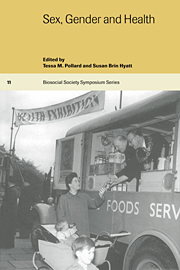Book contents
- Frontmatter
- Contents
- List of contributors
- Preface
- 1 Sex, gender and health: integrating biological and social perspectives
- 2 Parental manipulation of postnatal survival and well-being: are parental sex preferences adaptive?
- 3 Gender bias in South Asia: effects on child growth and nutritional status
- 4 Sex, gender and cardiovascular disease
- 5 Social meanings and sexual bodies: gender, sexuality and barriers to women's health care
- 6 Poverty and the medicalisation of motherhood
- 7 The vanishing woman: gender and population health
- 8 Agency, opposition and resistance: a systemic approach to psychological illness in sub-dominant groups
- Glossary
- Index
2 - Parental manipulation of postnatal survival and well-being: are parental sex preferences adaptive?
Published online by Cambridge University Press: 07 December 2009
- Frontmatter
- Contents
- List of contributors
- Preface
- 1 Sex, gender and health: integrating biological and social perspectives
- 2 Parental manipulation of postnatal survival and well-being: are parental sex preferences adaptive?
- 3 Gender bias in South Asia: effects on child growth and nutritional status
- 4 Sex, gender and cardiovascular disease
- 5 Social meanings and sexual bodies: gender, sexuality and barriers to women's health care
- 6 Poverty and the medicalisation of motherhood
- 7 The vanishing woman: gender and population health
- 8 Agency, opposition and resistance: a systemic approach to psychological illness in sub-dominant groups
- Glossary
- Index
Summary
Concerned to know the truth about the incidence of female infanticide in the Swatow region of Imperial China, missionary and naturalist Adele Fielde “took accounts from forty women … each over 50 years of age.” She found that the women had borne a total of 183 sons and 175 daughters, however, they had destroyed 78 of their daughters.
(Wolf and Huang 1980:231)Introduction
In many societies people have been reported to kill infants of the ‘wrong’ sex. For most of these societies the ‘wrong’ or undesired sex is female. Female infanticide is well known in parts of India and China; it is also recorded in the Americas, Melanesia, many pre-modern European societies, and is thought to occur, or have occurred, in approximately 9% of the world's cultures (Minturn and Stashak 1982). Male infanticide is much less common, but has been reported for 2–3% of societies. Where infanticide is prohibited sexbiased investment in their children by parents is widespread. Sons and daughters, for instance, may experience differential provisioning: many African groups are reported as breastfeeding girls for longer than boys, while Asian, Latin American, and some European cultures seem to favour breastfeeding males for longer (Hrdy 1987:99). In societies with a strong son preference, combined with the technological means for reliable fertility control (e.g. Korea), parents pursue the ‘ideal’ family format of more sons than daughters via a sequential decision-making process (Park 1983).
- Type
- Chapter
- Information
- Sex, Gender and Health , pp. 18 - 36Publisher: Cambridge University PressPrint publication year: 1999
- 1
- Cited by



